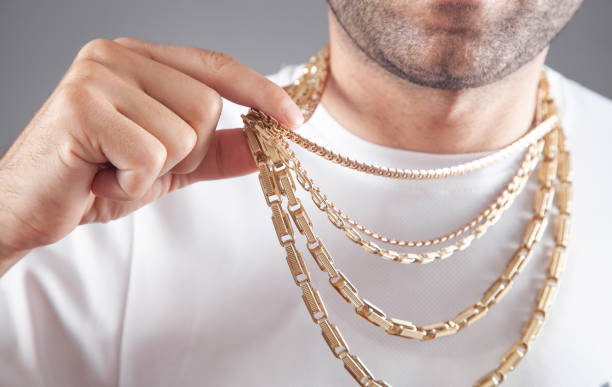Layering gold chains used to be something only fashion insiders knew how to pull off, but it’s become way more accessible once you understand a few basic principles. The key isn’t just throwing on multiple necklaces and hoping for the best – it’s about creating intentional combinations that look effortless rather than overdone. Versatile gold chains for every outfit can completely transform your jewelry game when you know how to mix lengths, textures, and weights properly. Here’s how to master the layered look without looking like you raided someone’s jewelry box.
The Foundation Chain Principle
Start with one chain that you absolutely love and that works well with most of your wardrobe. This becomes your foundation piece – something you can wear alone when you want to keep things simple, or build on when you want to create a more complex layered look.
Your foundation chain should be a length that works with your most common necklines. For most people, this means an 18 or 20-inch chain in a classic style like cable or figaro. It should be substantial enough to hold its own but not so bold that it dominates everything else you might add to it.
Think of this foundation piece as your jewelry equivalent of a great pair of jeans – something that goes with everything and makes putting together other combinations much easier.
The Two-Chain Rule for Beginners
If you’re new to layering, start with just two chains and get comfortable with how that looks before adding more. The most foolproof combination is pairing a shorter chain (16-18 inches) with a longer one (20-22 inches).
The key is making sure there’s enough difference in length that they don’t compete with each other or get tangled together constantly. At least 2-3 inches difference in length usually works well, though this depends on your specific proportions.
For textures, try pairing a delicate chain with something slightly more substantial, or mix a simple cable chain with something that has more visual interest like a rope or figaro style.
Mixing Chain Weights and Textures Successfully
Here’s where a lot of people go wrong – they either choose chains that are too similar and look accidental, or they go completely opposite directions and create visual chaos. The sweet spot is having some variation but maintaining overall harmony.
Try pairing a thin, delicate chain with a medium-weight piece rather than going from super thin directly to super chunky. The progression should feel gradual rather than jarring.
Texture mixing works really well when you have one simple, classic piece and one with more visual interest. For example, a basic cable chain looks great with a rope chain, or a snake chain pairs beautifully with a figaro style.
Working with Different Gold Tones
The old rule about never mixing gold tones is pretty much dead, but you do need to make it look intentional rather than accidental. The easiest way to mix metals is to include at least two pieces in each tone, so it looks like a deliberate choice rather than a mistake.
Rose gold plays really well with yellow gold because they’re both warm tones. White gold and yellow gold require a bit more care, but they can work beautifully together if you have confidence in the combination.
If you’re nervous about mixing metals, start small. Maybe add one rose gold piece to your yellow gold layers, or incorporate a white gold chain with mostly yellow pieces.
Layering with Pendants and Charms
This is where layering gets really fun but also where it can go wrong quickly. The trick is to not put pendants on every single chain – that gets busy and cluttered looking really fast.
Choose one chain to feature a pendant and keep the others simple. Usually, the longest chain works best for pendants because it creates a nice focal point without interfering with the other layers.
If you want to include multiple pendants, make sure they’re different sizes and don’t compete with each other. A small charm on a short chain can work with a larger pendant on a longer chain, as long as they’re not sitting at the same level.
Creating Occasion-Appropriate Layered Looks
For work or professional settings, stick to two or three chains maximum, and keep everything relatively minimal. Thin chains in similar metals work well and add interest without being distracting in meetings.
Evening looks can handle more drama. This is where you can bring in your statement pieces, mix more metals, or add chains with interesting textures or pendant combinations.
Casual everyday layering is probably where you’ll do most of your experimenting. This is the perfect time to try new combinations and see what works with your regular wardrobe.
Practical Storage and Maintenance Tips
Layered chains get tangled if you just throw them in a jewelry box together. Individual pouches or hanging each chain separately prevents the frustration of spending ten minutes untangling them every time you want to wear them.
If you have combinations that you wear together regularly, consider storing those chains together but use small clips or ties to keep them from tangling while stored.
Clean your chains regularly, especially if you layer them often. Body oils and lotions can build up more quickly when you’re wearing multiple pieces, and different metals can affect each other if they’re not kept clean.
Building Your Layering Collection Strategically
Instead of buying random chains and hoping they work together, think about building a collection where each piece serves multiple purposes. Every new chain should work well on its own and with at least two other chains you already own.
Start with different lengths in the same metal family, then gradually add texture variations and maybe branch out into other gold tones once you’re comfortable with the basics.

